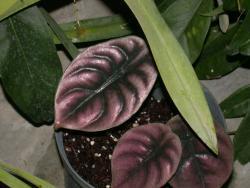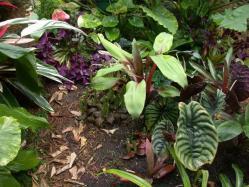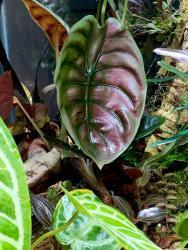Probably THE most sought after Alocasia at the moment behind Alocasia 'Dragon Scale', A. cuprea was first published to science in 1861 by Koch. It was extremely popular as a houseplant in Europe during the 'exploration' stage when people were growing plants indoors in Glass Boxes (early terrariums) and in large glass greenhouses and conservatories. But it gradually fell out of favor as plants sometimes do.
Cuprea is endemic to Borneo, growing in shaded humid forests on steep slopes above streams up to an elevation of about 2400 feet. It was first believed to be an isolated group that was only found on Mt. Kinabalu in Sabah, but was later found to also grow wild in Sarawak. However, it is considered rare in the wild. It later became more plentiful in cultivation around 2004/5 when specimens were put into tissue culture in Asian labs and made available to nurseries.
Borneo is one of the richest places on the planet for aroids. Its humid tropical forests have over 250 species in about 27 genus, and the Alocasia are one of the most widespread of these. Borneo has over 30 species of Alocasia, most are endemic. Many other alocasias of the 'jewel' group come from here, other highly collectible ones of the present time include A. nebula, A. Reginula, and A. melo which are found growing on limestone slopes and outcroppings.
The leaves of A. cuprea are almost peltate (having no or only a very small sinus) and very ovate. The undersides are purple, and the top sides can be silver, green or coppery colored. The green form of is actually considered a separate species, A. clyprolata (also called Green Shield). Some people believe that the silvery and more red forms are two different forms, but having grown this plant off and on since about 2007, it has been my experience that they are the same plant, and that the leaf color varies with the amount of light the plant receives. I know others will disagree. That's ok.
As to the proper home culture of this plant, it should be noted that it is very slow growing, and comes from a place where the humidity in the southeast states of the US would be considered dry. Yet, it grows naturally in locales that proves for very fast drainage of water, so that its roots are not kept wet. I grow mine currently in a terrarium in a mix that emulated the ABG (Atlanta Botanical Gardens) terrarium/vivarium mix. It is very chunky and very loose. Some people grow in a mixture of bark chips, pumice/crushed lava rock or very coarse perlite, chopped coconut husk and small amounts of peat. Bright light/dappled shade is optimal, and warmth year round is a necessity not as luxury, as is adequate humidity.
As recently as 2 years ago, these plants were available locally here for $10-12 each. Now, they are only available at great cost in the US (anywhere from $80-200 on the usual new 'nursery' sites like ETSY and eBay. )
These are a few photos past and present of plants I have grown and am currently growing. When I grew these in my greenhouse, they were incredibly sensitive to cold, and went dormant several times in temps that were below 60F at night. They did come back, until my heater failed one winter and many things froze. Which is why I grow them in a terrarium now.
My first started plant





